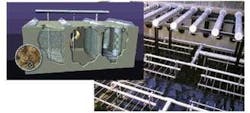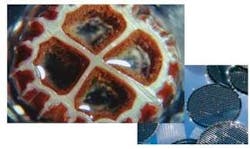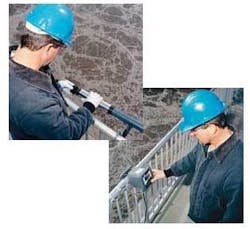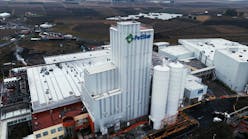Groundwater Remediation: Biofilm Reactor Process Benefits from Long-Term DO Sensor Reliability, Performance
Because dissolved oxygen (DO) is often one of the few essential control points with biofilm reactor processes, precise and uninterrupted DO monitoring and control is critical. When unreliable probes threatened to become an Achilles heel for an otherwise robust and highly efficient treatment system, the system provider turned to a luminescent DO measurement technology to solve the problem.
Biofilm treatment processes are being used increasingly for enhanced organics removal and nitrification of industrial and municipal wastewater. When International Specialty Products (ISP) in Linden, New Jersey needed to replace its aged conventional plant two years ago, it elected to install Kaldnes Moving Bed® Biofilm Reactor (MBBR) technology because of its small footprint and robust treatment. The MBBR process is not susceptible to upsets like conventional processes.
Biological VOC Removal
The process train for the ISP treatment plant project in New Jersey includes settled metals precipitation followed by an equalization basin where dosing of nutrients takes place using phosphoric acid and ammonium hydroxide as nutrient sources. Following an incubation period, the treated water flows to the MBBR, which aerates the biomass. Following MBBR treatment, flows proceed to an effluent sand filter for additional solids polishing, followed by a retention zone for pH adjustment and effluent monitoring prior to discharge.
"ISP chose MBBR technology for biological removal of volatile and semi-volatile organic compounds," says Chandler Johnson, Chief Technical Officer for AnoxKaldnes, Inc., the MBBR technology provider. "With this process ISP is achieving a greater than 95 percent removal of the targeted chemicals."
A stainless steel wedgewire sieve is used to retain the media within the reactor. The vigorous action of the moving bed continually scours the surface of the sieve, eliminating the need for maintenance. A perforated, stainless steel aeration grid mounted at the bottom of the reactor is connected to high efficiency blowers, producing a medium-sized bubble that evenly diffuses the oxygen across the bottom surface of the tank to provide the necessary mixing. The MBBR system treats 186,000 gallons per day, uses a 13-foot diameter reactor tank with a 21-foot water depth, providing a volume capacity of approximately 21,000 gallons.
DO Control Critical
With the MBBR process, Johnson says DO concentration is the critical measurement for process control. "DO is the big thing. If you maintain a positive dissolved oxygen level in the tank, the system self-regulates – operators really don't need to do anything, as long as pretreatment nutrients are not overdosed. Sufficient oxygen just needs to be pumped into the system at all times to ensure an active biomass."
To achieve this, the MBBR system is equipped with fully automated DO control. A DO probe inside the reactor monitors dissolved oxygen levels in the system and this continuous measurement data is used to control the blowers providing air to the medium-bubble aeration system.
One of the drawbacks to this control approach, according to Johnson, had long been the poor durability of the DO probes available on the market. "We never had good luck with the standard membrane-type DO probes because they would get too beat up in the reactor. Our biofilm carrier media would puncture the probe's membranes. Unprotected probes lasted only a few days in this environment. Even shielded probes didn't last long. Plus, when the probes were working, operators had to recalibrate them almost every day."
The unreliability of the DO probes required adjusting the blowers in the MBBR process slightly higher to play it safe. In order to achieve consistently tight DO control in its aeration process, the MBBR technology provider decided to evaluate a luminescent DO probe, the Hach LDO® probe.
The LDO probes, unlike galvanic and polarographic DO sensors, do not consume oxygen as part of the measurement process. Membrane-type DO probes rely on the consumption of oxygen at one electrode and the resulting current flowing through electrolyte to the second electrode.
In conventional wastewater treatment processes, the life of the LDO sensor is considerably longer than that of traditional DO technologies. This is partly because there are no membranes or electrolyte solutions to replace. No time-consuming calibrations are required, and frequent cleanings are also not required; the system will produce accurate DO readings.
The performance evaluation under MBBR conditions also showed the LDO probe to be a robust instrument for long-term reliability and performance. "Unshielded membrane probes lasted just a few days in the MBBR, while unshielded LDO probes in the system lasted a couple of months," Johnson says. "And once we shielded the LDO probes by placing them inside a basket-shaped screen we experienced no problems and no recalibrations have been necessary."
Due to the successful evaluation, AnoxKaldnes now includes LDO probes for online measurement and control of dissolved oxygen in all its new industrial MBBR installations. After more than a year of continuous operation, calibration tests run on the LDO probe at the ISP plant showed the unit remained precisely calibrated. In addition, no maintenance has been required.
At the ISP plant, the on-line LDO probe installed in the MBBR system is continuously read by a Hach Digital Controller that communicates to the system's programmable logic controller (PLC) for tight process control. The on-line system automatically controls the blower's variable speed drives based on current DO levels to maintain optimum DO concentrations in the system at all times. "We want a minimum of 3 mg/L DO in the system," Johnson says. "If the DO gets too high, the blowers will automatically turn back to a minimum of 50 percent speed, regardless of what the DO is. If the DO goes below 3 mg/L, the blowers kick up to full speed. This not only saves operators time, it saves on power consumption.
The Digital Controller linked to the LDO probe has a built-in datalogger that collects measurements at user selectable intervals (1 to 15 minutes), along with calibration and verification points, alarm history, and instrument setup changes for up to six months. The controller is designed to receive data from up to two sensors simultaneously, and the two probes plugged into a single Digital Controller need not be for the same parameter. In addition to the LDO probe, ISP's MBBR system also uses a Hach pHD™ Differential pH Digital Sensor. The pH sensor does not need to be shielded inside the reactor. The unit's replaceable salt bridge holds an extraordinary volume of buffer to extend the working life of the sensor by protecting the reference electrode from harsh process conditions.
Johnson says the LDO and pH probes were easy to install and program. "It was basically plug and play. The Controller automatically detected which probes we were using, the probes were calibrated, and we just had to make sure we had the correct probe tied into the right line. We then scrolled through the start-up procedure in the manual and we were ready to go – it took about 15 minutes to program everything."
Positive Results
With the addition of LDO probes to replace standard membrane-type probes to monitor dissolved oxygen levels, the MBBR process has gained more accurate and more efficient DO control. DO measurements are now constant, repeatable and reliable. The technology provider has now standardized the LDO probes and Hach platform for all its industrial MBBR installations, gaining robust DO measurement for long-term reliability and performance of the system.
New Technology
Hach has recently released its next generation LDO probe, the LDO® Model II Optical Dissolved Oxygen Probe. This new probe requires no calibration for the entire 2 year life of the sensor cap, which means it is ready to start measuring DO right out of the box. In addition, a cutting-edge 3D calibration procedure is conducted for each probe at the factory resulting in a probe that will not drift and is more accurate than ever before.




